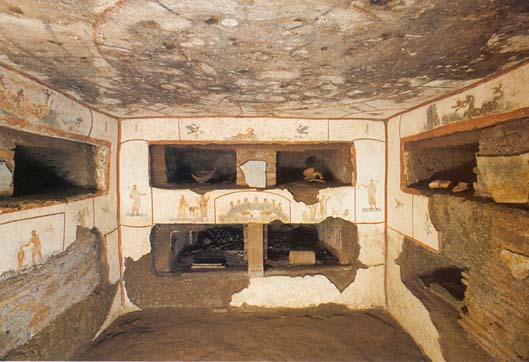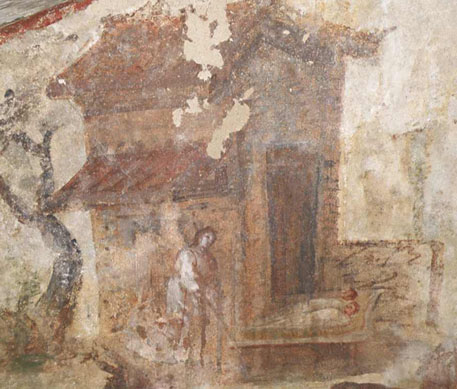Roma antica foro romano colosseo altare della patria circo massimo roma virtuale 3d lazio
catacombe-eng
inglese



Catacombs of Rome
 The catacombs in Rome are made up of tunnels and underground passages, and they seem veritable maze to reach a total length of many kilometers.
The catacombs in Rome are made up of tunnels and underground passages, and they seem veritable maze to reach a total length of many kilometers.
On the walls of this intricate system of tunnels were dug rectangular niches, called loculi of various sizes, which could contain only one body, but often contained the bodies of two people and sometimes more.
The Christians were wrapped in a sheet or shroud, without the cash. The loculi were closed with a slab of marble or tiles fixed by mortar. On the tombstone was written the name of the deceased, with a Christian symbol or a wish for peace in the sky. It was also customary to put the Oil lamps and small vases containing perfumes near the tombs.
The tombs gave the idea of a large dormitory, called the cemetery, from the Greek word meaning "resting place". In this way, Christians wanted to affirm their belief in the resurrection of the body.
The most famous:
-Catacombs of Domitilla, 00147 - via delle Sette Chiese, 282 / 280 - tel. 065110342 / 065133956 - fax 065135461 (closed Tuesdays)
-Catacombs of St. Sebastian, 00179 - Via Appia Antica, 136 - tel. 06 788 7035 fax 067843745 (closed Sundays)
-Catacombs of St. Callisto, 00179 - Via Appia Antica, 126 - tel. 06 513 01 51 / 06 513 01 580 - fax 06 513 01 567 (closed Wednesdays)
The Aureli hypogeum
 Casually discovered during the construction of a garage in autumn of 1919, the Aureli hypogeum is rich with frescoes that adorn its walls. The recent restorations brought back the original colors, bringing to light important details which questioned the hypothesis formulated so far by the various researchers, who for almost a century have tried in vain to reveal the meaning of the paintings. The rooms are frescoed with scenes which are difficult to interpret and enigmatic, datable around 230. The hypogeum has two floors, the upper composed of a room that originally was semi-hypogeal (underground construction) of which only the inferior part remains, 5 meters below and the lower floor composed of two specular and completely hypogeal rooms. With its 3 frescoed rooms the Aureli hypogeum is one of the most enigmatic monuments of Rome, the decorations in fact have various interpretations which attribute it to official Christianity, to various heretical sects, to philosophical issues or to pure paganism.
Casually discovered during the construction of a garage in autumn of 1919, the Aureli hypogeum is rich with frescoes that adorn its walls. The recent restorations brought back the original colors, bringing to light important details which questioned the hypothesis formulated so far by the various researchers, who for almost a century have tried in vain to reveal the meaning of the paintings. The rooms are frescoed with scenes which are difficult to interpret and enigmatic, datable around 230. The hypogeum has two floors, the upper composed of a room that originally was semi-hypogeal (underground construction) of which only the inferior part remains, 5 meters below and the lower floor composed of two specular and completely hypogeal rooms. With its 3 frescoed rooms the Aureli hypogeum is one of the most enigmatic monuments of Rome, the decorations in fact have various interpretations which attribute it to official Christianity, to various heretical sects, to philosophical issues or to pure paganism.
